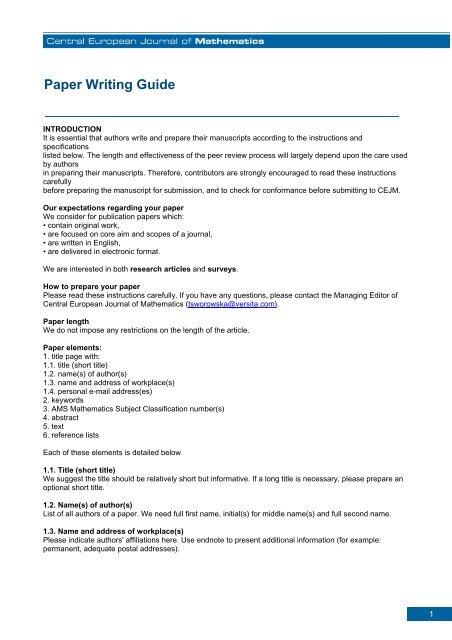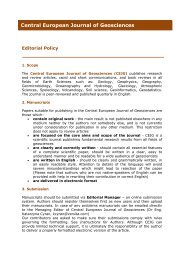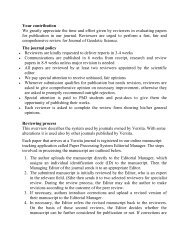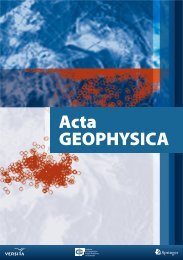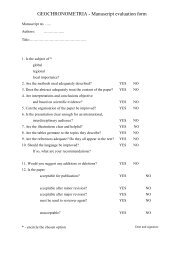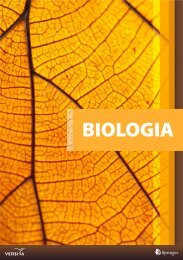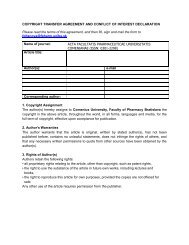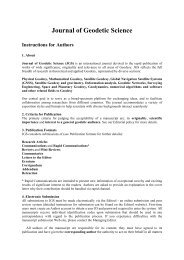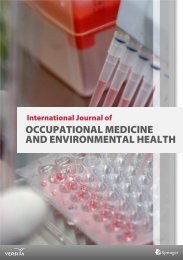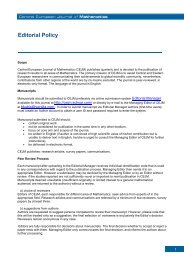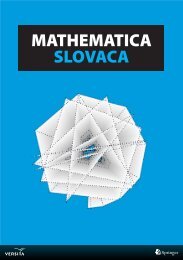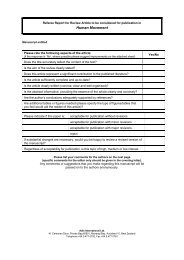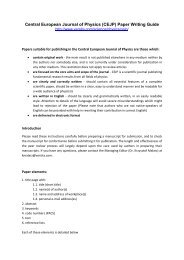Paper Writing Guide - Versita
Paper Writing Guide - Versita
Paper Writing Guide - Versita
You also want an ePaper? Increase the reach of your titles
YUMPU automatically turns print PDFs into web optimized ePapers that Google loves.
<strong>Paper</strong> <strong>Writing</strong> <strong>Guide</strong><br />
INTRODUCTION<br />
It is essential that authors write and prepare their manuscripts according to the instructions and<br />
specifications<br />
listed below. The length and effectiveness of the peer review process will largely depend upon the care used<br />
by authors<br />
in preparing their manuscripts. Therefore, contributors are strongly encouraged to read these instructions<br />
carefully<br />
before preparing the manuscript for submission, and to check for conformance before submitting to CEJM.<br />
Our expectations regarding your paper<br />
We consider for publication papers which:<br />
• contain original work,<br />
• are focused on core aim and scopes of a journal,<br />
• are written in English,<br />
• are delivered in electronic format.<br />
We are interested in both research articles and surveys.<br />
How to prepare your paper<br />
Please read these instructions carefully. If you have any questions, please contact the Managing Editor of<br />
Central European Journal of Mathematics (tsworowska@versita.com).<br />
<strong>Paper</strong> length<br />
We do not impose any restrictions on the length of the article.<br />
<strong>Paper</strong> elements:<br />
1. title page with:<br />
1.1. title (short title)<br />
1.2. name(s) of author(s)<br />
1.3. name and address of workplace(s)<br />
1.4. personal e-mail address(es)<br />
2. keywords<br />
3. AMS Mathematics Subject Classification number(s)<br />
4. abstract<br />
5. text<br />
6. reference lists<br />
Each of these elements is detailed below<br />
1.1. Title (short title)<br />
We suggest the title should be relatively short but informative. If a long title is necessary, please prepare an<br />
optional short title.<br />
1.2. Name(s) of author(s)<br />
List of all authors of a paper. We need full first name, initial(s) for middle name(s) and full second name.<br />
1.3. Name and address of workplace(s)<br />
Please indicate authors' affiliations here. Use endnote to present additional information (for example:<br />
permanent, adequate postal addresses).<br />
1
1.4. Personal e-mail address(es)<br />
The author's e-mail address is required. For multiple authorship, we need at least the personal e-mail<br />
address of the corresponding author.<br />
2. Keywords<br />
List all keywords separated by commas.<br />
3. Code number(s) for the scientific field<br />
Please include AMS Mathematics Subject Classification number(s) to which the paper can be attributed.<br />
More than a single classification number may be accepted.<br />
• AMS Mathematics Subject Classification, see http://www.ams.org/msc/<br />
4. Abstract<br />
An abstract should accompany every article. It should be a brief summary of significant results of the paper.<br />
An abstract should give concise information about the content of the core idea of your paper. It should be<br />
informative and not only present the general scope of the paper but also indicate the main results and<br />
conclusions.<br />
An abstract should not exceed 200 words. It should not contain literature citations, allusions to the tables,<br />
tables, figures or illustrations. All nonstandard symbols and abbreviations should be defined.<br />
In combination with the title and keywords, an abstract is an indicator of the content of the paper.<br />
Please remember that online systems rely heavily on the content of titles and abstracts to identify articles in<br />
electronic bibliographic databases and search engines. We ask you to take great care in preparing these<br />
elements.<br />
5. Text<br />
General rules for writing:<br />
- use simple and declarative sentences, avoid long sentences, in which the meaning may be lost by<br />
complicated construction;<br />
- be concise, avoid idle words;<br />
- make your argumentation complete; use commonly understood terms; define all nonstandard symbols and<br />
abbreviations when you introduce them;<br />
- explain all acronyms and abbreviations when they first appear in the text;<br />
- use all units consistently throughout the article;<br />
- be self-critical as you review your drafts.<br />
Structure of a paper:<br />
Research papers and review articles should follow a strict structure. Generally a standard scientific paper is<br />
divided into:<br />
- introduction: present the subject of your paper clearly, indicate the scope of the subject, present the goals<br />
of your paper and finally the organization of your paper;<br />
- main text: present all important elements of your scientific message;<br />
- conclusion: summarize your paper.<br />
Footnotes/Endnotes/Acknowledgements:<br />
We encourage authors to restrict the use of footnotes. If necessary, please make endnotes rather than<br />
footnotes. A footnote/endnote may include:<br />
• the designation of the corresponding author of the paper;<br />
• the current address of an author (if different from that shown in the affiliation);<br />
• traditional footnote content.<br />
Information concerning research grant support should appear in a separate Acknowledgements section at<br />
the end of the paper, not in a footnote. Acknowledgements of the assistance of colleagues or similar notes of<br />
appreciation should also appear in the Acknowledgements section, not in footnotes.<br />
2<br />
2
Tables:<br />
You should use tables only to improve conciseness or where the information cannot be given satisfactorily in<br />
other ways. Tables should be numbered serially and referred to in the text by number. Each table should<br />
have an explanatory caption which should be as concise as possible.<br />
Figures:<br />
You may use line diagrams and photographs to illustrate theses from your text. The figures should be clear,<br />
easy to read and of good quality. Styles and fonts should match those in the main body of the article.<br />
English language:<br />
Central European Journal of Mathematics is published in English. Make sure that your manuscript is clearly<br />
and grammatically written. The mathematical content should be understandable and should not cause any<br />
confusion to the readers, including the referees. After accepting the manuscript for a publication in CEJM we<br />
offer a free language check service, for correcting small language mistakes.<br />
6. Reference lists<br />
References should be listed alphabetically. A complete reference should give the reader enough<br />
information to find the relevant article. Please pay particular attention to spelling, capitalization and<br />
punctuation here. Completeness of references is the responsibility of the authors. A complete reference<br />
should comprise the following:<br />
Published manuscripts<br />
Necessary components are:<br />
Surname Initials.,<br />
Title,<br />
Abbreviated journal name (according to Mathematical Reviews Serials Abbreviations, see<br />
http://www.ams.org/msnhtml/serials.pdf),<br />
Year of publication,<br />
Volume,<br />
First page--Last page<br />
Examples:<br />
• Nowak P., New axioms for planar geometry, Eastern J. Math., 1999, 1, 324—334, (in Polish)<br />
• Kittel S.J., Maria G., Tuke M., Sepran D.J., Smith J., Tadeuszewicz K., et al., New class of<br />
measurable functions, J. Real Anal., 1997, 999, 234—255<br />
Manuscripts in press<br />
Necessary components are:<br />
Surname Initials.,<br />
Title,<br />
Abbreviated journal name, (in press),<br />
DOI<br />
Examples:<br />
• Kittel S.J., Maria G., Tuke M., Sepran D.J., Smith J., Tadeuszewicz K., et al., Measurable functions,<br />
J. Real Anal., (in press), DOI: 12.3412/01<br />
• Nowak P., New axioms for planar geometry, Eastern J. Math., (in press, in Polish), DOI:<br />
33.1122/321<br />
Books<br />
Necessary components are:<br />
Surname Initials.,<br />
Title,<br />
Edition (if not the first),<br />
Publisher,<br />
3
Place of publication,<br />
Year of publication<br />
Example:<br />
• Sambrook J., Russell D.W., Abelian groups, 3rd ed., Nauka, Moscow, 2001<br />
Chapter in a book<br />
Necessary components are:<br />
Surname Initials.,<br />
Title,<br />
In: Surname Initials. followed by (Ed.) or (Eds.) if relevant,<br />
Title of the book,<br />
Edition (if not the first),<br />
Publisher,<br />
Place of publication,<br />
Year of publication<br />
Example:<br />
• Sambrook J., Uncountable abelian groups, In: Sambrook J., Russell D.W. (Eds.), Contributions to<br />
Abelian groups, 3rd ed., Nauka, Moscow, 2001<br />
More information --> see CEJM <strong>Guide</strong>lines to bibliographic references<br />
Make sure the information is correct so that the linking reference service may link abstracts electronically.<br />
Before submitting your article, please ensure you have checked your paper for any relevant references you<br />
may have missed.<br />
Submission formats<br />
We accept the following formats:<br />
• LaTeX, AMSTeX, AMSLaTeX<br />
If you are able to supply (additionally) a PDF file, it will speed up the peer review process of your paper.<br />
REMARK: We do not accept Plain TeX format !<br />
Supplementary data<br />
You can also submit any data files and additional figures in attachments. These elements can be submitted<br />
in any of the usual formats (PDF, PS, EPS, TeX, GIF, TIFF, etc.). It is possible that we may not be able to<br />
open your data files. To prevent any misunderstandings we request that authors submit a text file<br />
(instruction.txt) containing brief instructions on how to use the attached files.<br />
4<br />
4


